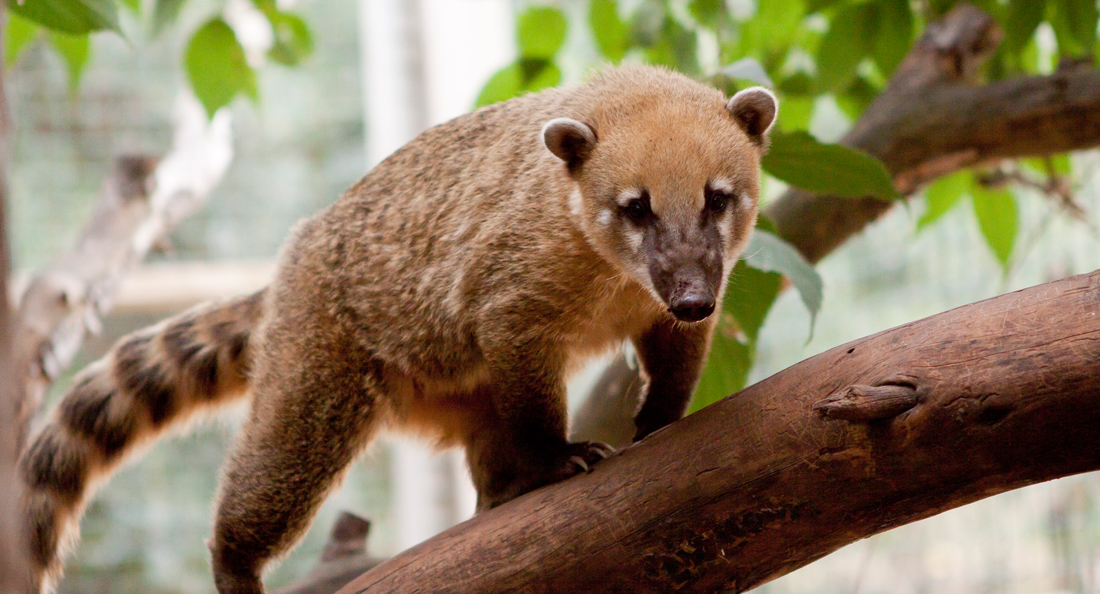Report on Coati
Introduction
The coati (Nasua), also known as the coatimundi, is a member of the raccoon family, Procyonidae, and is native to North, Central, and South America. Coatis are diurnal animals, meaning they are active during the day, and are known for their playful and inquisitive behavior. There are four recognized species of coati: the white-nosed coati (Nasua narica), the South American coati (Nasua nasua), the Cozumel Island coati (Nasua nelsoni), and the mountain coati (Nasuella olivacea).

Physical Description
Coatis are medium-sized mammals with an average body length of 33–69 cm (13–27 in) and a tail almost as long as their body, which can grow up to 60 cm (24 in). Their tails are often banded with rings, though the visibility of the rings can vary depending on the individual. They have long, flexible noses that they use for sniffing out food, strong claws for digging, and sharp teeth for eating a variety of foods.
Their fur is usually brown, reddish, or grey, with some species featuring white markings on their snout, throat, and chest. Coatis are relatively lightweight, with adult males weighing about 4–6 kg (8.8–13.2 lbs) and females being slightly smaller.
Habitat and Range
Coatis are highly adaptable and can be found in various habitats, including tropical and subtropical rainforests, dry scrub forests, and even human-populated areas. Their range extends from southern Arizona and New Mexico in the United States through Mexico and Central America, down into South America as far as Argentina and Uruguay.
They are excellent climbers and spend much of their time in trees, though they also forage on the ground. Coatis use their long tails to maintain balance while navigating through the treetops.

Behavior
Coatis are known for their highly social behavior, particularly the females and young, who live in groups called bands. These bands can consist of up to 20 individuals. Males, on the other hand, are usually solitary and only join the group during mating season.
These animals communicate using a variety of vocalizations, including grunts, chirps, and whistles. They are also known to be quite curious, often investigating new objects or areas with their long noses.
Diet
Coatis are omnivores and have a diverse diet that includes fruits, insects, small vertebrates, and eggs. They use their sharp claws to dig for grubs and insects and their long snouts to probe into crevices for food. Their diet can change depending on the season and the availability of resources.
Reproduction and Lifespan
Mating occurs during the rainy season, and after a gestation period of about 75 days, female coatis give birth to litters of 3–7 young. The young are raised in nests built in the trees, and after a few weeks, they join the band. Coatis reach sexual maturity at around 2–3 years of age.
In the wild, coatis typically live for 7–8 years, though some have been known to live up to 15 years in captivity.
Predators and Threats
Coatis face predation from a variety of animals, including large birds of prey, snakes, and mammals like jaguars, pumas, and ocelots. To protect themselves, coatis rely on their agility and group defense tactics, where the band will cooperate to fend off threats.
Human activity, such as deforestation and habitat destruction, poses a significant threat to coati populations. Additionally, they are sometimes hunted for their meat or captured for the pet trade.
Conservation Status
While coatis are not currently considered endangered, habitat loss and hunting in certain areas are causes for concern. Some species, like the Cozumel Island coati, have very limited ranges and face greater risks due to their small population sizes.
Conclusion
Coatis are fascinating, adaptable creatures that play an essential role in their ecosystems as both predators and prey. Their social behavior and diverse diet make them a unique member of the animal kingdom. However, continued conservation efforts are necessary to ensure that coati populations remain stable, particularly in regions where their habitat is under threat.
Are you ready for the comprehension test?
Quiz - Test Yourself
study worksheet
 ,
,
This content is available as a student activity in PDF format.
It includes:
Informational Text
Written Comprehension Questions
Multiple Choice Questions
True or False Comprehension Questions
A Report OF the Student: Translating understanding and revealing the facts of the topic.
Crossword Puzzle: To enhance understanding.
Word Search
This is a rich and enjoyable resource for the student, containing activities that are crucial to their learning and motivation, encouraging them to focus
"A rich and diverse range of activities"
How to buy this product ? Watch the video below


.png)

